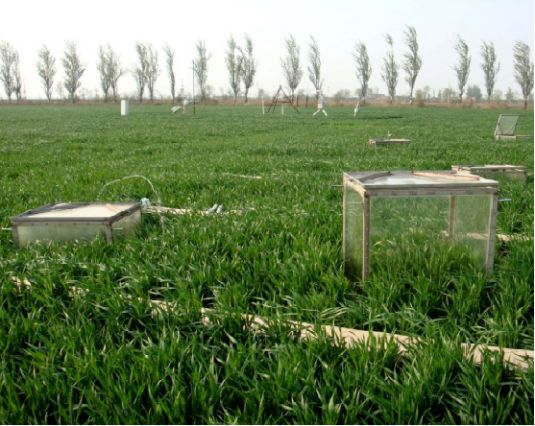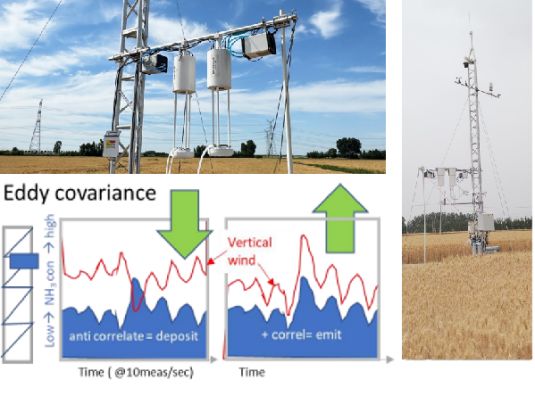 Home - TDLAS modules - Applications - Focusing on the Eddy Covariance (EC) Method: The Optimal Method for In Situ, Unperturbed, High-Frequency Observation of NH3/N2O Fluxes
Home - TDLAS modules - Applications - Focusing on the Eddy Covariance (EC) Method: The Optimal Method for In Situ, Unperturbed, High-Frequency Observation of NH3/N2O Fluxes
The current methods for calculating gas fluxes include the Chamber Method, the Gradient Method, and the Eddy Covariance Method.
Chamber Method
The Chamber Method is a technique that calculates gas flux by collecting gas samples in an enclosed or semi-enclosed space (known as a "chamber" or "box") and measuring the change in gas concentration over time. It is usually divided into static and dynamic chamber methods.

Static Chamber Method: The chamber is fixed on the ground or other surfaces, sealing a certain volume of air, and then measuring the change in gas concentration over time.
Dynamic Chamber Method: The gas inside the chamber is continuously renewed through an air circulation system, thereby measuring the change in gas concentration.
Advantages:
Simple and easy to use: The equipment is simple, and the operation is easy, suitable for various sites.
High sensitivity: Capable of detecting low-concentration gases, especially suitable for the measurement of trace gases.
Local measurement: Suitable for small-scale, high-precision local flux measurements, such as gas exchange of soil, plants, or water bodies.
Disadvantages:
Poor representativeness: Due to the limited measurement range, the results may not represent the overall flux of a large-scale area.
Disturbance effect: The chamber may change the natural state of gas exchange, affecting the measurement results.
Intermittent measurement: Usually short-term measurement, not suitable for long-term continuous monitoring.
Applications:
Research on soil respiration, plant transpiration, wetland methane emissions, small water body gas flux, etc.
Automated Gradient Method (AGM)
The Gradient Method calculates gas flux by measuring the gas concentration gradient at different heights or positions, combined with wind speed and other meteorological parameters. The AGM system is highly automated and can continuously and in real-time collect gas concentration gradient data.

Advantages:
Continuous monitoring: Suitable for long-term, continuous monitoring of gas flux.
Suitable for various environments: Applicable to gas flux measurement in flat terrain, atmospheric boundary layer, and other scenarios.
Automated operation: High degree of automation in data collection and processing, reducing human error.
Disadvantages:
Data complexity: Calculating flux with the Gradient Method involves comprehensive analysis of meteorological parameters, and data processing is complex.
Strong environmental dependence: Sensitive to environmental factors such as wind speed, stability, and terrain, which may affect measurement accuracy.
Applications:
Research on atmospheric pollution diffusion, greenhouse gas flux monitoring, boundary layer gas exchange research.
Eddy Covariance Method (EC)
The Eddy Covariance Method is a method that directly measures the gas flux between the atmosphere and the surface. By high-frequency measurement of the covariance of vertical wind speed and gas concentration, the gas flux is calculated. This method is widely used in ecosystem, climate change, and atmospheric research.

Advantages:
In situ, unperturbed measurement: Measures gas flux in the natural environment without disturbing the ecosystem.
Large-scale application: Suitable for large-scale ecosystems such as forests, wetlands, farmlands, etc., for gas flux monitoring.
Long-term continuous monitoring: Capable of long-term continuous monitoring, capturing seasonal or interannual changes.
Disadvantages:
Expensive equipment: The cost of instruments and equipment is high, and maintenance is complex.
Complex data processing: Requires high-frequency data collection and complex data processing techniques.
Terrain limitations: Measurement results may be inaccurate on complex terrains or uneven surfaces.
Applications:
Ecosystem carbon flux monitoring, greenhouse gas emission research, climate change impact assessment.
Comparison and Summary
The Chamber Method is suitable for precise measurements of small-scale areas but has issues with disturbance effects and insufficient representativeness, mainly used for small-scale studies such as soil and vegetation.
The Gradient Method is suitable for measuring gas fluxes in larger areas such as the atmospheric boundary layer, especially with advantages in automation and continuous monitoring, but data processing is complex and dependent on environmental conditions.
The Eddy Covariance Method is the standard method for studying gas exchange in large-scale ecosystems. Although the cost of equipment and data processing is high, its unperturbed, continuous measurement characteristics make it irreplaceable in long-term ecosystem research.
 Tel:+86-400 961 6990 Email:info@healthyphoton.com
Add:Room 305, Building 1, Zhongchuang Science Park, Jinyuan Road, Panhuo Street, Yinzhou District, Ningbo City,China
Tel:+86-400 961 6990 Email:info@healthyphoton.com
Add:Room 305, Building 1, Zhongchuang Science Park, Jinyuan Road, Panhuo Street, Yinzhou District, Ningbo City,China


